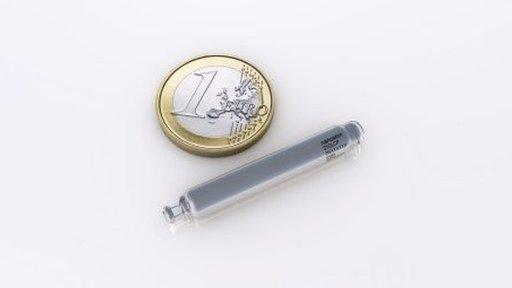Tiny, wireless pacemaker due to be launched in Europe
- Published

The device does not require invasive surgery to be implanted
A miniaturised, wireless pacemaker that can be inserted into the body without invasive surgery has been given approval for use in the European Union.
Developed by US start-up Nanostim, the device is designed to be implanted intravenously directly in the heart.
It is less than 10% of the size of a conventional pacemaker and uses a built-in battery.
Experts said it was an "exciting development" but at a very early stage.
The pacemaker has yet to receive full US Food and Drug Administration (FDA) approval.
Conventional pacemakers require a patient to be cut open and a pocket created in the body to house the pacemaker and associated wires.
Such wires are regarded as the component of pacemakers most likely to fail. The pocket created for the pacemaker is also liable to infection.
By contrast the Nanostim pacemaker is delivered via a catheter inserted through the femoral vein near the groin.
It has a built-in battery, smaller than an AAA battery, that lasts between nine and 13 years. Eliminating the need for wires lowers the risk of infection or malfunction and means that patients are not restricted in the amount of activity they do, the firm behind the device claims.
The procedure to fit the pacemaker typically lasts around half an hour. The device is designed to be easily retrievable so that the battery can be replaced.
Because the device is delivered intravenously, it also means patients will have no scarring.
One doctor, involved in its trials, described it as "the future of pacemaking".
"For the past 40 years the therapeutic promise of leadless pacing has been discussed, but until now, no-one has been able to overcome the technical challenges," said Dr Johannes Sperzel of the Kerchhoff Klinik in Bad Nauheim, Germany.
"This revolutionary technology offers patients a safe, minimally-invasive option for pacemaker delivery that eliminates leads and surgical pockets," he added.
Better understanding
But others were more cautious.
Prof Jeremy Pearson, associate medical director at the British Heart Foundation, said: "This is a potentially exciting development but it's early days.
"Before this leadless pacemaker becomes widely available, we need a better understanding of how long it will last, as well as how easy it is to replace if necessary. As our knowledge of this new pacemaker widens, so too will the expertise needed to fit this potentially exciting device."
The company behind the device has recently been bought by global medical device firm St Jude.
It has had several wire-based pacemakers recalled in recent years.
Other device makers are also planning to go wireless. The Wireless Cardiac Stimulation system has been developed by US start-up EBR Systems and UK-based tech firm Cambridge Consultants and uses a tiny wireless electrode no bigger than a grain of rice powered by an ultrasonic pulse generator, inserted lower down in the chest.
In 2011 the device was implanted in 100 patients in hospitals across Europe.
Cardiac pacemakers are used to treat slow heart rates. The devices monitor the heart and provide electrical stimulation when the heart beats too slowly.
The first pacemaker was fitted in 1958. Currently more than four million people around the world have some sort of cardiac rhythm device with an additional 700,000 people getting one each year.
- Published26 August 2013
- Published28 March 2013
- Published16 December 2012